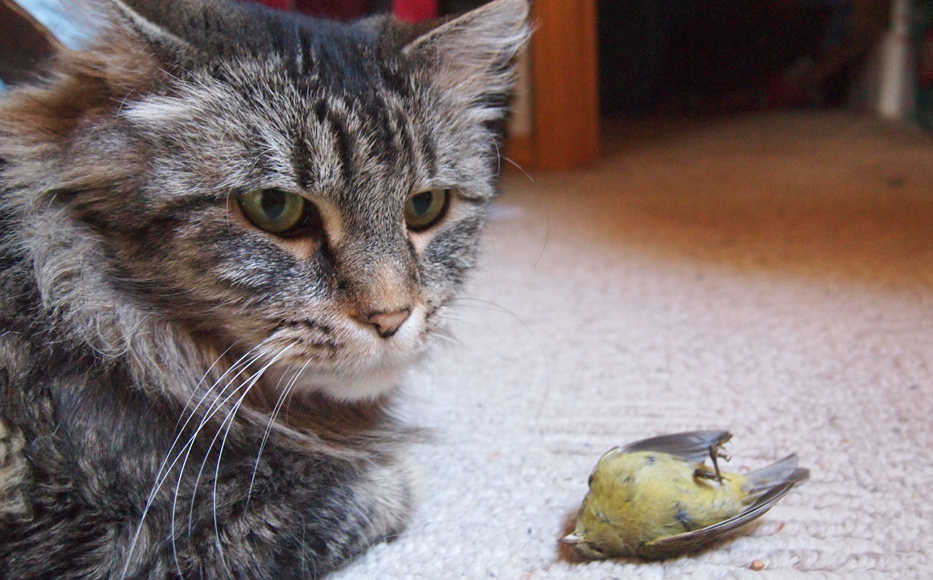The debate over whether cats should be confined indoors or allowed to roam outside is one that affects many people personally. Often it comes down to a conflict between a neighbor who does not like to see cats in their yard or discover cat feces in their garden and the cat lover who thinks their pet does not cause any problems and should be allowed to walk around outside and enjoy the sunshine. Many outdoor cat owners will tell you that they feel guilty keeping a cat “imprisoned,” and don’t feel it would be a good life if they couldn’t go outside. Let me preface this story with the fact that I have a strictly inside cat. I have read many of the studies that try to estimate the number of birds killed annually by our feline pets and can’t fathom numbers in the billions.
This spring while on a family vacation, we spent time at a friend’s house on the outskirts of Los Angeles. This was a beautiful neighborhood with tons of trees and brush lining the back of their property. Viewed on Google Earth it was apparent they lived very much in a green belt with miles of pavement covering the landscape in all directions. I envisioned the birding was going to be awesome as there was no other place for birds to be than this “green” neighborhood. This was going to be like birding in New York City’s Central Park.
Upon arrival I noticed a few cats in the back yard and my dreams of a birding Mecca were soon dashed. The owners are super nice and caring people and what they had been doing is feeding the stray cats in the neighborhood, catching them and paying to have them neutered or spayed, and then releasing them. I asked how many cats they were feeding and they reported that in the last few years they had captured at least 50 different cats. Again, these are nice people that truly care about all animals, trying to fix a problem they did not create.
The next morning I awoke early to see what birds might still be around and the neighborhood was full of song! There were birds in the tall poplar and citrus trees in the back yard including Cedar Waxwings, Orange-crowned Warblers and several Black-chinned Hummingbirds. The level of devastation these cats were having on the wild bird population was not apparent until we drove to a nearby park where there were no (or at least fewer) free ranging cats. As soon as I got into similar habitat with no cats I was seeing the same species from the back yard and many more. The most striking difference was the number of different species of sparrows in the cat free area. Then it dawned on me and I pulled out my list to confirm. The only species I saw in the back yard of our friend’s house were birds that lived high in the tree canopy. Not a single ground dwelling bird remained in the cat-rich area. On the surface it seemed like there were lots of birds flitting around and singing, but it was a barren wasteland for ground-loving species.
So let’s do some quick math. There are estimates of 85 million cats with owners in the U.S. (pet cats). There are possibly an additional 70 million ownerless (feral) cats. Roughly 78 percent of pet cats spend time outdoors (58.5 million). A study conducted by Kerrie Anne Loyd at the University of Georgia, using cameras attached to 60 urban cats showed what cats do when they are “out.” Thirty percent of the study cats successfully killed prey including lizards, voles, chipmunks, birds, frogs, and snakes. It is risky to extrapolate the results from this study to the rest of the U.S., but let’s do it for conversation sake. Pet cats would only have to kill a bird once every 3 weeks to reach 1 billion dead birds annually. The 70 million feral cats are likely killing many more birds, so 1 billion dead birds is not a stretch at all.
The study also found that less than 25 percent of the kills were brought back to the house. Most owners probably have no idea what there cats are actually catching while they are out. If your cat is bringing a bird back to the house once every 84 days (almost 3 months), that is enough to produce 1 billion dead birds from pet cats alone. We are also entering the time of year when baby birds are popping out flightless and wandering around until they get their wings. They don’t stand a chance against free ranging pet or feral cats. One third of all bird species in North America are declining and it is likely the hurdles faced by these species will not get any easier. Is it time to re-evaluate what it means to be a responsible cat owner in the U.S.? If we are going curb the decline in bird species across North America it starts with finding inside homes for cats, not out.
Todd Eskelin is a Wildlife Biologist at the Kenai National Wildlife Refuge. He specializes in birds and has conducted research on songbirds in many areas of the state. Find more information athttp://www.fws.gov/refuge/kenai/ or http://www.facebook.com/kenainationalwildliferefuge.

